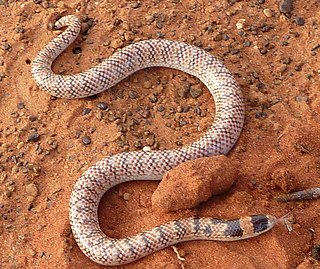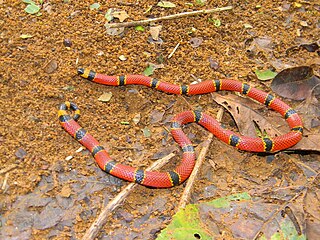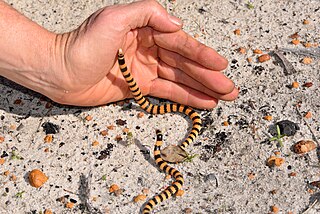
Underwoodisaurus is a small genus of Australian lizards in the family Carphodactylidae. Member species are commonly known as thick-tailed geckos, along with the species Uvidicolus sphyrurus.

Cryptoblepharus is a genus of skinks

The Anomochilidae, or anomochilids, are a monotypic family of snakes, created for the genus Anomochilus, which currently contains three species. It is commonly called dwarf pipe snake.

Aspidites is a genus of pythons endemic to Australia. The name can be translated as "shield bearer" and pertains to the symmetrically shaped head scales. Currently, two species are recognized.

Acanthophis is a genus of elapid snakes. Commonly called death adders, they are native to Australia, New Guinea and nearby islands, and are among the most venomous snakes in the world. The name of the genus derives from the Ancient Greek akanthos/ἄκανθος ('spine') and ophis/ὄφις ('snake'), referring to the spine on the death adder's tail.

Children's python is a species of nonvenomous snake in the family Pythonidae. The species is named after John George Children. It is a nocturnal species occurring in the northern half of Australia and generally found on the ground, although it often climbs trees. Usually growing to about 1.0 m (3 ft) in length or more depending on the polymorphic variant, it is typically a reddish-brown colour, darker on the upper surface, and with many darker blotches, especially on younger specimens. The Stimson's python variant has much stronger and more variable colors; often being adorned with reddish-brown to chocolate blotches against lighter tan. It feeds mostly on small mammals and birds, and as with other pythons, it constricts its prey before swallowing it whole. It is a popular pet among reptile enthusiasts.

The woma python, also known commonly as Ramsay's python, the sand python, and simply the woma, is a species of snake in the family Pythonidae. The species is endemic to Australia. Once common throughout Western Australia, it has become critically endangered in some regions.

Indotyphlops braminus, commonly known as the brahminy blind snake and other names, is a nonvenomous blind snake species found mostly in Africa and Asia, but has been introduced in many other parts of the world. They are completely fossorial animals, with habits and appearance similar to earthworms, for which they are often mistaken, although close examination reveals tiny scales rather than the annular segments characteristic of true earthworms. The species is parthenogenetic and all known specimens have been female. The specific name is a Latinized form of the word Brahmin. No subspecies are currently recognized.

Sea snakes, or coral reef snakes, are a subfamily of elapid snakes, the Hydrophiinae, that inhabit marine environments for most or all of their lives. Most are venomous, except the genus Emydocephalus, which feeds almost exclusively on fish eggs. Sea snakes are extensively adapted to a fully aquatic life and are unable to move on land, except for the genus Laticauda, which has limited land movement. They are found in warm coastal waters from the Indian Ocean to the Pacific and are closely related to venomous terrestrial snakes in Australia.

Aipysurus laevis is a species of venomous sea snake found in the Indo-Pacific. Its common names include golden sea snake, olive sea snake, and olive-brown sea snake.

Aipysurus is a genus of venomous snakes in the family Elapidae. Member species of the genus are found in warm seas from the Indian Ocean to the Pacific Ocean.

Brachyurophis is a genus of elapid snakes known as shovel-nosed snakes, so named because of their shovel-nosed snout which is used to burrow. The genus has eight recognized species, which are all found in Australia.

Hydrophis peronii, commonly known as the horned sea snake, Peron's sea snake, and the spiny-headed seasnake, is a species of venomous snake in the subfamily Hydrophiinae of the family Elapidae. The species is endemic to the western tropical Pacific Ocean. It is the only sea snake with spines on the head. Like all other members of the family Elapidae, it is venomous. It is sometimes placed in its own genus Acalyptophis.
Anilios endoterus, formally Ramphotyphlops endoterus, is commonly known as the interior blind snake. It is one of 42 species of snake in the genus Anilios (Ramphotyphlops) from the Typhlopidae family living in Australia. These snakes appear to be blind, only having vestigial eyes that are extremely sensitive to light. It is a cryptic burrowing snake that lives in tunnels underground, living mainly on a diet of ants. They are found in arid and semi-arid desert regions of central Australia and are considered endangered in New South Wales (NSW).

Micrurus browni, commonly known as Brown's coral snake, is a species of venomous elapid snake native to southwestern Mexico and Guatemala. There are three recognized subspecies, including the nominate subspecies described here.

Brachyurophis fasciolatus is a species of snake from the family Elapidae, commonly named the narrow-banded shovel-nosed snake, or narrow-banded burrowing snake, and is a species endemic to Australia. Its common names reflect its shovel nose specialization, burrowing behaviour and banded body colour.
Brachyurophis incinctus is a species of snake from the family Elapidae, commonly named the unbanded shovel-nosed snake, and is a species endemic to Australia. Its common name reflects its shovel nose specialisation, burrowing behaviour and the fact that it is not banded on its body.

Brachyurophis australis is a species of snake from the family Elapidae and is a species endemic to Australia. Its common name reflects its shovel nose specialisation.
Brachyurophis morrisi, also known as the Arnhem shovel-nosed snake, is a species of venomous burrowing snake that is endemic to Australia. The specific epithet morrisi honours author and naturalist Ian James Morris for his contributions to knowledge of the animals of the Northern Territory, who first collected the species in 1970.

Simoselaps bertholdi, also known commonly as Jan's banded snake or the southern desert banded snake, is a species of burrowing venomous snake in the family Elapidae. The species is endemic to Australia.
















